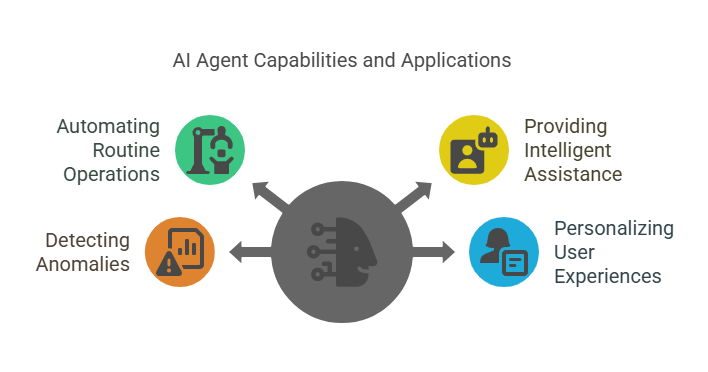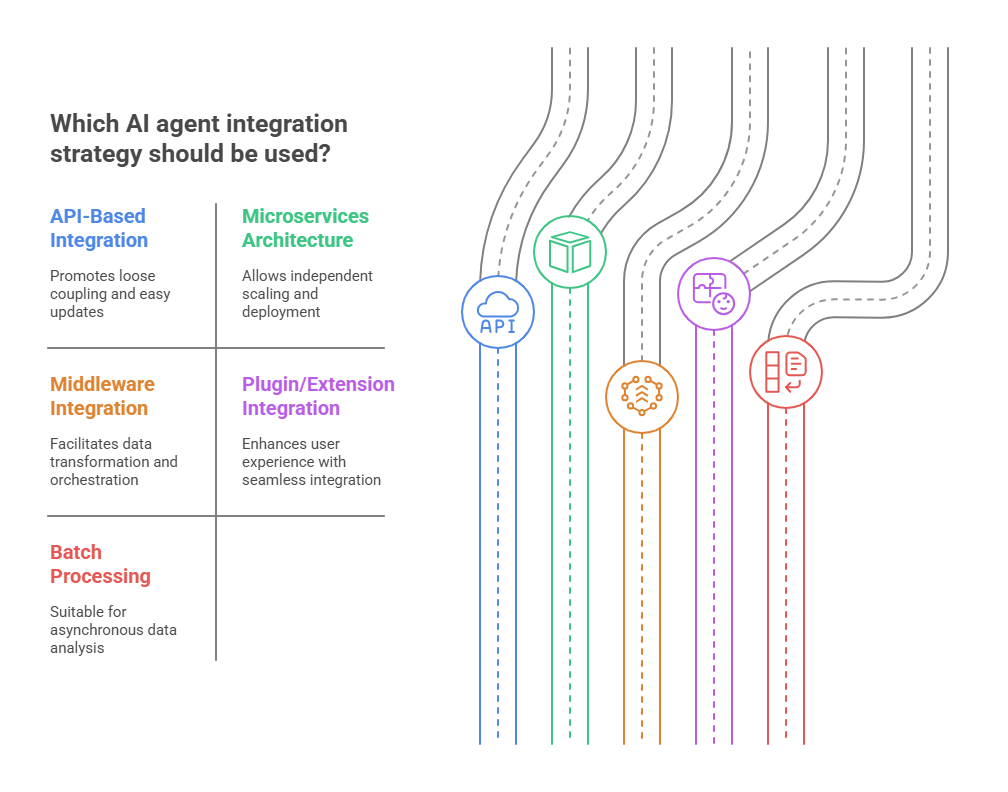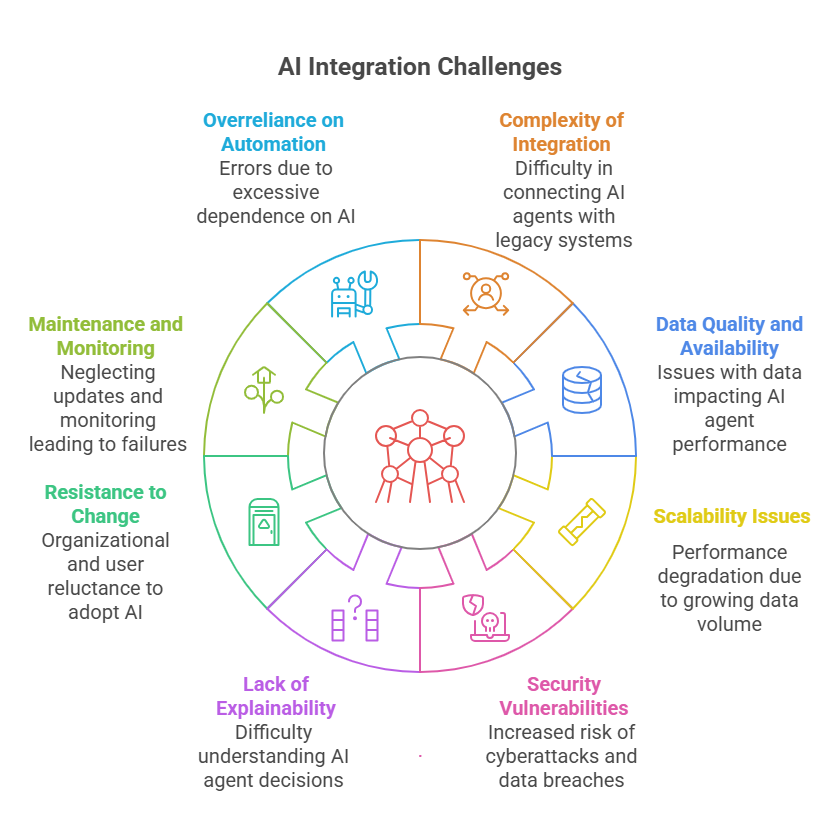Introduction: The Importance of AI Agent Integration
In today’s rapidly evolving technological landscape, artificial intelligence (AI) agents are becoming increasingly vital components of modern software systems. These autonomous entities are designed to perform tasks, make decisions, and interact with users or other systems with minimal human intervention. Integrating AI agents into existing applications offers a powerful way to enhance functionality, improve efficiency, and unlock new capabilities without the need to rebuild software from scratch.
The importance of AI agent integration lies in its ability to bring intelligence and automation to legacy systems and established applications. Many organizations rely on software that has been developed over years or even decades, often built on architectures that were not originally designed to support AI functionalities. By embedding AI agents into these systems, businesses can modernize their applications incrementally, adding features such as natural language processing, predictive analytics, personalized recommendations, and automated decision-making.
Moreover, AI agents can help bridge gaps between disparate systems by acting as intelligent intermediaries that facilitate communication, data processing, and workflow automation. This integration enables more seamless user experiences and operational efficiencies, reducing manual workloads and accelerating response times.
Another key benefit is scalability. AI agents can operate independently or collaboratively, allowing applications to handle increasing complexity and volume without proportional increases in human oversight. This is particularly valuable in domains such as customer service, finance, healthcare, and manufacturing, where timely and accurate responses are critical.
However, integrating AI agents into existing applications is not without challenges. It requires careful planning to ensure compatibility, maintain security, and preserve system stability. Understanding the architecture of the existing application, selecting appropriate AI technologies, and designing effective communication mechanisms are essential steps in the integration process.
Understanding AI Agents and Their Capabilities
AI agents are autonomous software entities designed to perceive their environment, make decisions, and perform actions to achieve specific goals. Unlike traditional programs that follow predefined instructions, AI agents exhibit adaptability, learning, and problem-solving abilities, enabling them to operate effectively in dynamic and complex environments.
There are several types of AI agents, each with varying levels of sophistication. Simple reactive agents respond directly to stimuli without internal state or memory, while more advanced deliberative agents maintain knowledge about their environment and plan actions accordingly. Learning agents go a step further by improving their performance over time through experience, often using machine learning techniques.
The core capabilities of AI agents include perception, reasoning, learning, and communication. Perception allows agents to gather data from their environment or users, which they analyze using reasoning algorithms to make informed decisions. Learning enables agents to adapt to new situations and optimize their behavior. Communication skills allow agents to interact with other agents, systems, or users, facilitating collaboration and coordination.
In the context of existing applications, AI agents can perform a wide range of tasks such as automating routine operations, providing intelligent assistance, detecting anomalies, and personalizing user experiences. For example, an AI agent integrated into a customer support system can understand user queries, retrieve relevant information, and offer solutions without human intervention.
Technologies enabling AI agents include natural language processing (NLP), computer vision, reinforcement learning, and knowledge representation. These technologies empower agents to handle unstructured data, learn from interactions, and reason about complex scenarios.
Understanding the nature and capabilities of AI agents is crucial for successful integration. It helps developers identify suitable use cases, select appropriate agent types, and design systems that leverage agent strengths while addressing their limitations. This foundational knowledge sets the stage for effectively embedding AI agents into existing software ecosystems to enhance functionality and user value.

Assessing Existing Application Architectures
Before integrating AI agents into existing applications, it is essential to thoroughly assess the current architecture of the software system. Understanding the structure, components, and communication patterns of the application helps identify the most effective integration points and strategies, ensuring a smooth and efficient enhancement process.
Most existing applications fall into common architectural categories such as monolithic, layered, client-server, or microservices. Each architecture presents unique opportunities and challenges for AI agent integration. For example, monolithic applications, where all components are tightly coupled, may require more careful planning to avoid disrupting core functionalities. In contrast, microservices architectures, with their modular and loosely coupled services, often provide more natural integration points for AI agents as independent services.
Key aspects to evaluate include the application’s data flow, APIs, communication protocols, and extensibility mechanisms. Identifying well-defined interfaces or service endpoints is crucial, as these serve as gateways through which AI agents can interact with the application. Additionally, understanding the data formats and storage systems used by the application helps ensure compatibility and efficient data exchange.
Another important consideration is the application’s scalability and performance characteristics. Integrating AI agents may introduce additional computational load or latency, so it is vital to assess whether the existing infrastructure can support these demands or if upgrades are necessary.
Security and compliance requirements must also be reviewed. AI agents often require access to sensitive data or system controls, so integration must adhere to established security policies and regulatory standards to protect data privacy and system integrity.
Finally, evaluating the development and deployment environment, including programming languages, frameworks, and DevOps practices, informs the choice of AI technologies and integration tools that best fit the existing ecosystem.
Integration Strategies and Approaches
Integrating AI agents into existing applications requires selecting appropriate strategies and approaches that align with the application’s architecture, business goals, and technical constraints. The choice of integration method significantly impacts the ease of implementation, system performance, and maintainability.
One common approach is API-based integration, where AI agents expose their functionalities through RESTful or gRPC APIs. Existing applications can invoke these APIs to leverage AI capabilities without deeply embedding the agent’s logic. This method promotes loose coupling, making it easier to update or replace AI agents independently.
Another strategy involves microservices architecture, where AI agents are developed as independent microservices. This approach fits well with modern applications designed around modular services, allowing AI agents to scale, deploy, and evolve separately. Microservices can communicate with the main application and other services via message queues, HTTP calls, or event-driven mechanisms.
Middleware integration is also popular, where AI agents act as intermediaries between different components of the application. Middleware can handle tasks such as data transformation, orchestration, and routing, enabling AI agents to process information and influence workflows without altering core application logic.
For applications with user interfaces, embedding AI agents as plugins or extensions can provide seamless user experiences. For example, AI-powered chatbots or recommendation engines can be integrated directly into web or mobile apps, enhancing interactivity and personalization.
In some cases, batch processing or offline integration is suitable, where AI agents analyze data asynchronously and feed results back into the application. This approach is common for tasks like predictive analytics or anomaly detection that do not require real-time interaction.
Choosing the right integration approach depends on factors such as the required level of interaction, latency tolerance, scalability needs, and existing technology stack. Combining multiple strategies is often necessary to address different use cases within the same application.

Challenges and Considerations in AI Agent Integration
Integrating AI agents into existing applications presents several challenges that developers and organizations must carefully address to ensure successful deployment and operation.
Compatibility and Interoperability: Existing applications may use diverse technologies, data formats, and communication protocols. Ensuring that AI agents can seamlessly interact with these heterogeneous components requires careful design of interfaces and data exchange mechanisms.
Performance Impact: AI agents often involve computationally intensive tasks such as machine learning inference or natural language processing. Integrating these agents without degrading the application’s responsiveness or scalability demands efficient resource management and possibly infrastructure upgrades.
Security and Privacy: AI agents may access sensitive data or control critical functions. Protecting against unauthorized access, data leaks, and adversarial attacks is paramount. Integration must comply with security best practices and relevant regulations, including data encryption, authentication, and audit logging.
Maintainability and Upgradability: AI technologies evolve rapidly. Designing integration solutions that allow easy updates or replacement of AI agents without disrupting the application is essential for long-term sustainability.
Data Quality and Availability: AI agents rely heavily on data. Incomplete, inconsistent, or outdated data can impair agent performance. Ensuring high-quality data pipelines and real-time access is a key consideration.
User Acceptance and Trust: Introducing AI agents may change user workflows or decision-making processes. Building transparent, explainable agents and providing users with control and feedback mechanisms helps foster trust and adoption.
Testing and Validation: Verifying that AI agents behave correctly within the application context requires comprehensive testing strategies, including unit tests, integration tests, and real-world scenario simulations.
Integration Complexity: Depending on the application’s architecture, integrating AI agents can range from straightforward API calls to complex middleware or microservices orchestration. Managing this complexity requires skilled teams and clear project management.
Data Management and Interoperability
Effective data management and interoperability are critical for the successful integration of AI agents into existing applications. AI agents rely on timely, accurate, and well-structured data to perform their tasks, making seamless data exchange and format compatibility essential.
Data Exchange Mechanisms: AI agents and applications often communicate through APIs, message queues, or shared databases. Choosing the right mechanism depends on factors like latency requirements, data volume, and system architecture. For real-time interactions, RESTful APIs or WebSocket connections are common, while batch processing may use file transfers or database synchronization.
Format Compatibility: Data formats must be compatible between agents and applications to avoid errors and data loss. Common formats include JSON, XML, and Protocol Buffers. Defining clear schemas and using serialization libraries help maintain consistency and ease parsing.
Data Synchronization: Ensuring that AI agents and applications operate on up-to-date data is vital. Synchronization strategies include event-driven updates, polling, or scheduled batch synchronization. Conflict resolution mechanisms should be in place when concurrent data modifications occur.
Data Quality and Validation: Poor data quality can degrade AI agent performance. Implementing validation checks, cleansing routines, and monitoring data pipelines helps maintain data integrity.
Interoperability Standards: Adopting industry standards and protocols facilitates integration across heterogeneous systems. Standards like OpenAPI for APIs or MQTT for messaging improve compatibility and reduce integration complexity.
Example: JSON Data Exchange in Python
Here is a simple Python snippet demonstrating how an AI agent might receive and process JSON data from an application:
python
import json
# Sample JSON data received from application
data_json = '{"user_id": 123, "action": "submit", "payload": {"text": "Hello AI Agent"}}'
# Parse JSON data
data = json.loads(data_json)
# Process data (simple echo response)
response = {
"user_id": data["user_id"],
"message": f"Received your action '{data['action']}' with payload: {data['payload']['text']}"
}
# Convert response to JSON for sending back
response_json = json.dumps(response)
print(response_json)This example illustrates basic data parsing and response formatting, which are foundational for interoperable communication between AI agents and applications.
Security and Privacy Considerations
Integrating AI agents into existing applications introduces new security and privacy challenges that must be carefully addressed to protect sensitive data and maintain system integrity.
Access Control and Authentication: AI agents often interact with critical systems and data. Implementing strong authentication mechanisms, such as OAuth or API keys, ensures that only authorized entities can access agent functionalities. Role-based access control (RBAC) helps limit permissions according to user or agent roles.
Data Protection: Sensitive data handled by AI agents should be protected both in transit and at rest. Using encryption protocols like TLS for communication and encrypting stored data prevents unauthorized access and eavesdropping.
Privacy Compliance: AI agents must comply with data privacy regulations such as GDPR or CCPA. This includes minimizing data collection, anonymizing personal information, and providing mechanisms for data subject rights like access and deletion.
Secure Coding Practices: Developers should follow secure coding guidelines to prevent vulnerabilities such as injection attacks, buffer overflows, or insecure deserialization. Regular code reviews and static analysis tools can help identify security flaws early.
Adversarial Threats: AI agents can be targets of adversarial attacks aiming to manipulate their behavior or extract sensitive information. Techniques like input validation, anomaly detection, and adversarial training can enhance agent robustness.
Audit and Monitoring: Maintaining logs of agent activities and access helps detect suspicious behavior and supports forensic analysis in case of incidents. Automated monitoring tools can alert administrators to potential security breaches.
Example: Simple API Key Authentication in FastAPI
Below is a Python example demonstrating how to secure an AI agent API endpoint using API key authentication:
python
from fastapi import FastAPI, Header, HTTPException
app = FastAPI()
API_KEY = "secret-api-key"
@app.get("/agent/data")
async def get_data(x_api_key: str = Header(...)):
if x_api_key != API_KEY:
raise HTTPException(status_code=401, detail="Unauthorized")
return {"message": "Secure data accessed by authorized agent"}
# To run: uvicorn filename:app --reloadThis example shows a basic method to restrict access to the AI agent’s API, which can be extended with more sophisticated authentication and authorization schemes.
Testing and Validation of Integrated Systems
Ensuring that AI agents work reliably and effectively within existing applications requires thorough testing and validation. This process helps identify issues early, verify that agents meet functional and performance requirements, and maintain system stability.
Unit Testing: Focuses on individual components of the AI agent, such as algorithms, data processing functions, or API endpoints. Writing automated unit tests ensures that each part behaves as expected in isolation.
Integration Testing: Verifies that AI agents interact correctly with other system components, including databases, external services, and user interfaces. This testing uncovers issues related to data exchange, communication protocols, and workflow coordination.
End-to-End Testing: Simulates real-world scenarios to validate the entire system’s behavior from input to output. This testing confirms that AI agents fulfill their intended roles within the application context.
Performance Testing: Measures the responsiveness, throughput, and resource usage of AI agents under various loads. Performance benchmarks help ensure that integration does not degrade overall system performance.
Robustness and Fault Tolerance Testing: Evaluates how AI agents handle unexpected inputs, network failures, or partial system outages. Testing for graceful degradation and recovery is crucial for maintaining reliability.
User Acceptance Testing (UAT): Involves end-users to validate that AI agents meet business needs and usability expectations. Feedback from UAT guides refinements and improvements.
Continuous Testing and Monitoring: Automated testing integrated into CI/CD pipelines enables rapid detection of regressions. Post-deployment monitoring tracks agent behavior and system health in production.
Example: Simple Unit Test for AI Agent Function
Here is a Python example using pytest to test a simple function of an AI agent:
python
# agent.py
def process_text(text):
return text.lower().strip()
# test_agent.py
from agent import process_text
def test_process_text():
assert process_text(" Hello AI Agent ") == "hello ai agent"
assert process_text("") == ""
assert process_text("TEST") == "test"Running these tests ensures that the process_text function behaves correctly across different inputs.
Case Studies: Successful AI Agent Integrations
Examining real-world examples of AI agent integration provides valuable insights into best practices, challenges, and tangible benefits. Below are a few illustrative case studies showcasing effective AI agent deployment within existing applications.
Case Study 1: AI-Powered Code Review Assistant
A software development company integrated an AI agent into their code review workflow. The agent automatically analyzed pull requests for common bugs, style inconsistencies, and security vulnerabilities. By connecting the agent via API to the version control system, developers received real-time feedback, reducing review times by 30% and improving code quality.
Key Takeaways:
Seamless API integration enabled smooth communication between the agent and existing tools.
Automated checks complemented human reviewers, enhancing productivity.
Continuous learning allowed the agent to adapt to project-specific coding standards.
Case Study 2: Customer Support Chatbot in E-commerce
An e-commerce platform deployed an AI agent chatbot to handle customer inquiries. The chatbot was integrated with the existing CRM and order management systems, allowing it to provide personalized responses, track orders, and escalate complex issues to human agents. This integration improved customer satisfaction and reduced support costs by 25%.
Key Takeaways:
Data interoperability ensured the chatbot had access to up-to-date customer and order information.
Security measures protected sensitive customer data during interactions.
Monitoring and analytics helped refine chatbot responses over time.
Case Study 3: Predictive Maintenance Agent in Manufacturing
A manufacturing company implemented an AI agent to monitor equipment health by analyzing sensor data streams. The agent predicted potential failures and triggered maintenance alerts integrated into the company’s existing ERP system. This proactive approach reduced downtime by 40% and optimized maintenance schedules.
Key Takeaways:
Real-time data processing and synchronization were critical for timely alerts.
Integration with ERP systems streamlined maintenance workflows.
Scalability considerations ensured the agent could handle large volumes of sensor data.
Challenges and Common Pitfalls
Integrating AI agents into existing applications presents several challenges and potential pitfalls that developers and organizations should be aware of to ensure successful deployment.
Complexity of Integration: Legacy systems may have outdated architectures or lack standardized interfaces, making it difficult to connect AI agents seamlessly. Overcoming this often requires custom adapters or middleware, increasing development time and cost.
Data Quality and Availability: AI agents depend heavily on high-quality, relevant data. Incomplete, inconsistent, or siloed data can impair agent performance and lead to incorrect decisions or actions.
Scalability Issues: As the number of AI agents or the volume of data grows, system performance can degrade if scalability is not properly planned. Insufficient infrastructure or poor design can cause bottlenecks and latency.
Security Vulnerabilities: Introducing AI agents expands the attack surface. Without proper security measures, agents can become entry points for cyberattacks or data breaches.
Lack of Explainability: Complex AI models may behave as “black boxes,” making it hard for developers and users to understand or trust agent decisions. This can hinder adoption and complicate debugging.
Resistance to Change: Organizational culture and user acceptance can pose barriers. Teams may be reluctant to rely on AI agents due to fear of job displacement or lack of trust in automated systems.
Maintenance and Monitoring: AI agents require ongoing updates, retraining, and monitoring to remain effective. Neglecting maintenance can lead to model drift, degraded performance, and system failures.
Overreliance on Automation: Excessive dependence on AI agents without human oversight can result in overlooked errors or unintended consequences, especially in critical applications.
Common Pitfalls to Avoid:
Skipping thorough testing before deployment.
Ignoring data privacy and compliance requirements.
Underestimating integration complexity and resource needs.
Failing to establish clear roles and responsibilities for AI agent management.
Neglecting user training and change management.

Future of AI Agents in Project Development
The future of AI agents in project development is poised to be transformative, reshaping how software is designed, built, and maintained. As AI technologies advance, agents will become more autonomous, intelligent, and deeply integrated into development workflows.
Increased Autonomy and Intelligence
AI agents will evolve from performing predefined tasks to making complex decisions, learning from experience, and adapting dynamically to changing project requirements. This will enable agents to handle more sophisticated roles such as architectural design suggestions, automated debugging, and proactive risk management.
Seamless Collaboration with Human Developers
Future AI agents will act as collaborative partners rather than mere tools. Enhanced natural language understanding and contextual awareness will allow agents to communicate effectively with developers, understand project goals, and provide meaningful assistance throughout the software lifecycle.
Integration with DevOps and Continuous Delivery
AI agents will be embedded within DevOps pipelines to automate testing, deployment, monitoring, and incident response. This integration will accelerate release cycles, improve software quality, and reduce downtime by enabling predictive maintenance and self-healing systems.
Personalization and Customization
Agents will tailor their behavior to individual developers’ preferences, coding styles, and project contexts. This personalization will increase productivity and satisfaction by providing relevant suggestions, automating repetitive tasks, and adapting to team workflows.
Ethical and Responsible AI Development
As AI agents gain influence in project decisions, ethical considerations will become paramount. Future development will emphasize transparency, fairness, and accountability, ensuring that AI agents support responsible software engineering practices.
Emerging Technologies and Paradigms
Advances in areas such as federated learning, explainable AI, and multi-agent systems will enhance the capabilities and trustworthiness of AI agents. Integration with blockchain and quantum computing may open new frontiers for secure, decentralized, and high-performance agent-based development.
Challenges and Opportunities
While the potential is vast, challenges remain in managing complexity, ensuring security, and fostering human-AI collaboration. Addressing these will require interdisciplinary research, robust frameworks, and continuous feedback from practitioners.
Game Theory in Intelligent Agents


